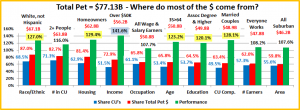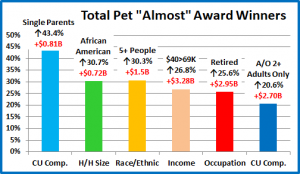2017 Total Pet Spending was $77.13B – Where did it come from…?
Total Pet Spending in the U.S. reached $77.13B in 2017, a $9.84B (14.6%) increase from 2016. These figures and others in this report are calculated from data in the annual Consumer Expenditure Survey conducted by the US BLS. It was a spectacular year for the industry, with the 3 largest segments registering double digit increases while Services spending fell less than 1%. The key factor in this consumer buying surge was value. Super Premium foods became more accessible in both location and price. Supply prices deflated, and both Service segments had record low inflation rates. Although the Service Segment spending fell, there was an increase in purchase frequency. Consumers just paid less. Consumers saw great value and they acted on it. This great success raises some interesting questions and deserves a closer look.
The first question is, “Who is spending most of the $77+ billion dollars?” There are of course multiple answers. We will look at Total Pet Spending in terms of 10 demographic categories. In each category we will identify the group that is responsible for most of the overall spending. Our target number was to find demographic segments in each category that account for 60% or more of the total. To get the finalists, we started with the biggest spending segment then bundled related groups until we reached 60%.
Knowing the specific group within each demographic category that was responsible for generating the bulk of Total Pet $ is the first step in our analysis. Next, we drill even deeper to show the best and worst performing demographic segments and finally, the segments that generated the biggest dollar gains or losses in 2017.
In the chart that follows, the demographic categories appear in ranked order by Total Pet market share from highest to lowest. We also included their share of total CU’s (Financially Independent Consumer Units) and their performance rating. Performance is their share of market vs their share of CU’s. This is an important number, not just for measuring the impact of a particular demographic group, but also in measuring the importance of the whole demographic category in Spending. These are all large groups with a high market share. A performance score over 120% means that this demographic measure is extremely important in generating increased Pet Spending. I have highlighted the 6 groups with 120+% performance. This is up from 5 in 2016, as the 35>64 yr old age group joined the club.
The groups are the same as in 2016, but some rankings have changed. All Wage Earners, 35>64 yr olds and Married Couples gained in importance while # Earners and Education fell in the ranking.
- Race/Ethnic – White, not Hispanic (87.0%) This is the 2nd largest group and accounts for the vast majority of Pet Spending. They increased their performance rating to 127%. This category now ranks #4 in terms of importance in Pet Spending demographic characteristics, up from 5th in 2016. Although we should note that this demographic, along with age, are the 2 areas in which the consumers have no control. Spending disparities are enhanced by differences in other areas like Income, CU Composition and homeownership. There are also apparently cultural differences which impact Pet Spending. Asian Americans rank first in income, education and spending but they rank last in Pet Spending as a percentage of total spending – 0.36% vs a national average of 0.99%.
- # in CU – 2+ people (82.7%) It just takes two. Singles have the lowest performance of any group. If you put 2 people together, pets very likely will follow. Their overall performance of 116.0% is lower than expected because performance decreases as the number of people in the CU increases, falling to 85.9% for CU’s with 5+ people.
- Housing – Homeowners (81.4%) Controlling your “own space” has long been the key to larger pet families and more pet spending. At 129.4% performance, homeownership still ranks 2nd in terms of importance for increased pet spending. The homeownership rate for Millennials is substantially lower than previous generations when they were the same age. However, it increased from 35% to 37% in 2017. This is definitely good news. Keep it up!
- Income – Over $50K (72.9%) Although Pet Parenting is common in all income groups, money does matter. With a performance rating of 141.6%, CU income is the single most important factor in increased Pet Spending. Their performance increased from 140.1% in 2016. However, the increase was driven by the whole range of middle income groups from $50K to $150, not just the elite $150+K.
- Occupation – All Wage & Salary Earners (65.8%) – Pet ownership is widespread across all segments in this group. In the past spending has been strongly skewed towards white collar workers. In 2017, the blue-collar workers stepped up. In share, the group moved up to 5th from 8th Their performance increased to 107.7% but is still low. It remains below 110% because there is still spending disparity within the group and retirees also had a great year!
- Age – 35>64 (65.8%) This group moved up in share of spending from 7th to 6th. Although the younger groups have increased their spending in recent years, this group of Boomers and Gen Xers was dominant in 2017. Their performance increased substantially from 118.6% to 123.2% and they joined the elite 120+% group – ranked 5th.
- Education – Associates Degree or Higher (64.5%) Income generally increases with education level and so does Pet spending. Education can also be a key factor in recognizing the value in product improvements, like super premium foods. In 2017 this higher educated group fell from 3rd to 7th in share of pet spending. This drop in ranking was due to another segment making a major move. In 2017, High School Grads with some College substantially increased their Veterinary spending but more importantly, they bought into Super Premium Foods in a big “blue wave”. I use this metaphor because there was a corresponding food spending lift by blue-collar workers. Higher Education is still an important factor in spending but the group performance dropped from 127.5% to 120.1% – from 3rd to 6th place.
- CU Composition – Married Couples (63.4%) With or without children, two people, committed to each other, is an ideal situation for Pet Parenting. In 2017, primarily due to married couples only CU’s, this group moved up from 8th to 7th in share of spending. They also increased their performance to 128.1%, which still ranks third in importance.
- # Earners – “Everyone Works” (62.0%) This is a composite of CU’s, regardless of size, where all adults are employed. This group’s ranking in share of overall pet spending fell from 5th to 9th. Their performance fell from 115.2% to 108.2%. Retirees and CU’s with 2+ people and only one earner have a significant share of Pet spending and both these groups had a great year, which caused this group to lose ground in all areas – despite a $3B spending increase.
- Area – Suburban (59.8%) Homeownership is high and they have the “space” for pets. Their share of spending fell slightly from 60.2%. Their performance also fell from 109.7 to 107.6%. The relatively low performance shows how widely spread pet parenting is in all areas. The drop in share and performance was due to a spectacular year by CU’s in Rural areas, in every industry segment, but especially Food.
Total Pet Spending is a sum of the spending in all four industry segments. The “big demographic spenders” listed above are determined by the total pet numbers. Although the share of spending and performance of these groups may vary between segments, every one of them generates a minimum of 55.1% of the spending in every segment. As we analyze individual segments, some of the groups will change to better reflect where most of the business is coming from.
The group performance is a very important measure. Any group that exceeds 120% indicates an increased concentration of the business which makes it easier for marketing to target the big spenders. Although Income over $50K is the clear winner, Homeowners and Married couples are also strong performers. The exceptionally high performance in all six 120+% groups also indicates the presence of segments within these categories that are seriously underperforming. These can be identified and targeted for improvement.
Now, let’s drill deeper and look at 2017’s best and worst performing segments in each demographic category.
Most of the best and worst performers are just who we would expect and there are only 3 that are different from 2016. Changes from 2016 are “boxed”. We should note:
- Income is very important, which is shown by the 238.5% performance. What is not seen is the radically improved performance from the groups from $40k to $150K as Pet Spending increased across a wide range of incomes.
- Occupation – Managers and Professionals returned to the top spot for the first time since 2014. The Self-employed loss 9% in CU’s and their income and pet spending plummeted. Blue-collar workers are still at the bottom, but their performance increased from 71% to 88% so the difference between the top and bottom narrowed.
- CU Composition – Married couple only is the winner for a second consecutive year and their performance is getting stronger. However, the big news is that Single Parents moved up and out of the “loser” spot.
- # in CU – It just takes 2 and 2 is by far the best performing CU number, regardless if they are married or unmarried.
- Region – The West is perennially on top. The loser changes almost every year but 92% performance is not too bad.
There was very little change in the “players”, so most expected segments are doing well. In the next section we’ll look at the segments who literally made the biggest difference in the success of 2017.
We’ll “Show you the money”! This chart details the biggest $ changes in spending from 2016.
In this section we will truly see the difference between 2017 and 2016. There are 22 Winners and Losers. None are repeats. In 8 cases the segments actually switched from the biggest increase to the biggest decrease or vice versa.
- Race/Ethnic – The vast majority of Spending comes from the White, Not Hispanic group…and 85% of the increase.
- Winner – White, Not Hispan – Spending: $67.14B; Up $8.36B (+14.2%)
- 2016: Hispanic
- Loser – Asian – Pet Spending: $1.62B; Up $0.37B (+29.4%)
- 2016: White, Not Hispanic
- Comment – All groups spent more. Asian Americans increased their Pet Spending by 29.4% and still came in last!
- Winner – White, Not Hispan – Spending: $67.14B; Up $8.36B (+14.2%)
- # in CU – 2 People is a logical winner. They have more time and money to focus on their pets.
- Winner – 2 People – Pet Spending: $35.32B; Up $6.87B (+24.2%)
- 2016: 4 People
- Loser – 1 Person – Pet Spending: $13.35B; Up $0.23B (+1/8%)
- 2016: 3 People
- Comment: All segments spent more on their pets , but 2 People CU’s generated 70% of the increase. Last year’s winner, 4 People CU’s, came within $0.01B of flipping from first to last. However, Singles “won”.
- Winner – 2 People – Pet Spending: $35.32B; Up $6.87B (+24.2%)
- Housing – The biggest segment, Homeowners w/Mtge hasn’t won since 2015.
- Winner – Homeowner no Mtge – Spent: $23.18B; Up $5.64B (+32.2%)
- 2016: Renter
- Loser – Renter – Pet Spending: $14.32B; Up $0.73B (+5.3%)
- 2016: Homeowner w/Mtge
- Comment – Renters flipped. Homeowners w/o Mtge had a lift in all segments. Retirees were a factor.
- Winner – Homeowner no Mtge – Spent: $23.18B; Up $5.64B (+32.2%)
- Earners – More earners generally mean a higher income and more Spending, but not this year.
- Winner – 1 Earner, 2+ CU – Pet Spending: $18.04B; Up $5.44B (+43.2%)
- 2016: 2 Earners
- Loser – No Earner, Single – Pet Spending: $4.60B; Up $0.04B (+0.9%)
- 2016: 1 Earner, 2+ CU
- Comment – After 2 years of the same Winner and Loser, the 1 Earner, 2+ CU group finally turned it around, in a big way. Even the low-income Single, No Earner group eked out an increase.
- Winner – 1 Earner, 2+ CU – Pet Spending: $18.04B; Up $5.44B (+43.2%)
- CU Composition – Up or down, the big changes usually come from some sub-segment of married couples.
- Winner – Married, Couple Only – $26.30; Up $5.30B (+25.2%)
- 2016: 2+ Unmarried Adults
- Loser – Married, oldest child <6 – $2.06B; Down -$0.54B (-20.8%)
- 2016: Married Oldest Child >18
- Comment – 2017 was the year of “2” and Married Couples with no human children, regardless of age, are showing a tremendous commitment to their pet “children”.
- Winner – Married, Couple Only – $26.30; Up $5.30B (+25.2%)
- Occupation – Pet Parents are widespread across occupations, but white-collar workers usually drive spending.
- Winner – Blue-Collar Workers – Spending: $14.6B; Up $4.36B (+42.5%)
- 2016: Mgrs & Professionals
- Loser – Self-Employed – Pet Spending: $5.41B; Down -$1.12B (-17.1%)
- 2016: Retired
- Comment – In 2017 the Blue-Collar workers were the big movers, largely due to a huge increase in Pet Food spending as they upgraded to super premium.
- Winner – Blue-Collar Workers – Spending: $14.6B; Up $4.36B (+42.5%)
- Age – The 55>64 yr olds definitely turned it around.
- Winner – 55>64 yrs – Pet Spending: $21.44B; Up $4.07B (+23.5%)
- 2016: 35>44 yrs
- Loser – <25 yrs – Pet Spending: $1.98B; Up $0.12B (+6.6%)
- 2016: 55>64 yrs
- Comment: Every age group spent more in 2017, but the 45>64 group accounted for 65% of the increase.
- Winner – 55>64 yrs – Pet Spending: $21.44B; Up $4.07B (+23.5%)
- Education – The Associates Degree CU’s went from first to last and were the only group to spend less in 2017.
- Winner – HS Grad, some College – Spent: $16.47B; Up $3.96B (+31.7%)
- 2016: Assoc. Degree
- Loser – Assoc. Degree – Pet Spending: $7.81B; Down -$0.39B (-4.8%)
- 2016: Adv. College Degree
- Comment – This year’s winner, High School Grads with Some College, demonstrates that Education has become less of a factor in Pet Spending, at least in some segments.
- Winner – HS Grad, some College – Spent: $16.47B; Up $3.96B (+31.7%)
- Area Type – All groups spent more, but Rural CU’s, the smallest group, led the way, spending more in all segments.
- Winner – Rural – Pet Spending: $10.04B; Up $3.43B (+51.9%)
- 2016: Central City
- Loser – Central City – Pet Spending: $20.93B; Up $0.78B (+3.9%)
- 2016: Suburbs >2500
- Comment – The biggest trend was that areas under 2500 pop., rural or urban, generated 61% of the increase.
- Winner – Rural – Pet Spending: $10.04B; Up $3.43B (+51.9%)
- Income – Only the $30>39K group spent less.
- Winner – $100 to $149K – Pet Spending: $15.02B; Up $3.32B (+28.4%)
- 2016: $200K>
- Loser – $30 to $39K – Pet Spending: $4.95B; Down -$0.93B (-13.8%)
- 2016: $100 to $149K
- Comment – The $100>149K group flipped from last to first but there were also strong increases in the mid-range income groups. Bundled together, the $40>99K income range increased spending by $5.17B.
- Winner – $100 to $149K – Pet Spending: $15.02B; Up $3.32B (+28.4%)
- Region – Regions vary in size and demographics, but all spent more and had at least a $1.9B increase.
- Winner – Midwest – Pet Spending: $16.43B; Up $2.92B (+21.6%)
- 2016: South
- Loser – West – Pet Spending: $18.56B; Up $1.93B (+11.6%)
- 2016: Midwest
- Comment – The Midwest flipped positions but the segments in this category are always changing positions.
- Winner – Midwest – Pet Spending: $16.43B; Up $2.92B (+21.6%)
We’ve now seen the best overall performers and the “winners” and “losers” in terms of increase/decrease in Total Pet Spending $ for 11 Demographic Categories. Not every good performer can be a winner but some of these “hidden” segments should be recognized for their outstanding performance. In such a great year, there were a number of candidates, but I limited my choices to 6. They don’t win an award, but they deserve….
HONORABLE MENTION
The 2017 performance of these groups doesn’t require a detailed explanation. The numbers on the chart demonstrate just how demographically widespread and significant the 2017 pet spending lift truly was.
Single Parents climbed out of the hole of being the perennial worst performer in their group. African Americans finished last in performance but still had a 30.7% increase. 2 Person CU’s “ruled” in 2017, but the biggest group, 5+ People was also up 30.3%. The $200K group was the best performer and the $100>150K group had the biggest increase, but the income range from $40>69K also spent $3.2B (26.8%) more in 2017. The focus was on the great year that was had by both Managers and Professionals and Blue-Collar workers, but Retirees also had a $2.95B increase. Finally, the spotlight was definitely on married couples only, but the 2+ Adults only group also did pretty well with a $2.7B increase. The good news was truly widespread. In fact, only 9 of 99 distinct demographic segments had a decrease. That means that 91% spent more.
Summary
2015 and 2016 brought turmoil to the market. There was a lift in spending in 2015 as many consumers upgraded to Super Premium foods, but they cut back on spending in other segments to help pay for it. In 2016 they began value shopping for food online and in stores. They used some of the money saved on food to spend on other segments, but not enough, as total spending fell slightly. Then came 2017, when the market was rampant with values. The Services segment saw increased purchase frequency, but consumers paid less. Other Segments had double digit increases and the movement to premium foods made a much deeper penetration across the market.
In 2017, on the surface, big changes weren’t immediately apparent. The demographic groups responsible for most of Total Pet Spending were the same as those in 2016. However, there were changes in their spending share rankings. The number of Earners and Higher Education became less important, while Marriage and Everyday Workers increased their influence. These were indications of a movement towards more spending equality in certain demographic categories.
In terms of performance, the most influential demographic big spending groups increased from 5 to 6, with the Top Three being Income, Home Ownership and Marriage. Knowing the demographic segments in these categories allows industry participants to more effectively target their best customers and… those most in need of improvement.
There was also very little change in the best and worst performing individual demographic segments. The most noticeable changes occurred in $. There were some surprising winners and “near winners” – Rural, Blue-Collar, HS Grads w/some College, $40>69K and Single Parents, to name a few. The most noticeable spending trends seem to be a movement towards more egalitarian spending in terms of income, education and occupation, along with significant growth in less densely populated areas. As always, to get to the heart of the matter and to more actionable data you must “drill down”. This will become even more apparent as we turn our analysis to the individual industry segments.
But before we go…The “Ultimate” Total Pet Spending Consumer Unit in 2017 consists of 2 people – a married couple, alone. They are in the 55 to 64 age range. They are White, but not of Hispanic origin. At least one of the them has an advanced College Degree. They both work as managers and are doing well – over $200K. They’re working to pay off their house located in a lovely, small suburb of a metropolitan area with a population of about 2,000,000 in the West.







